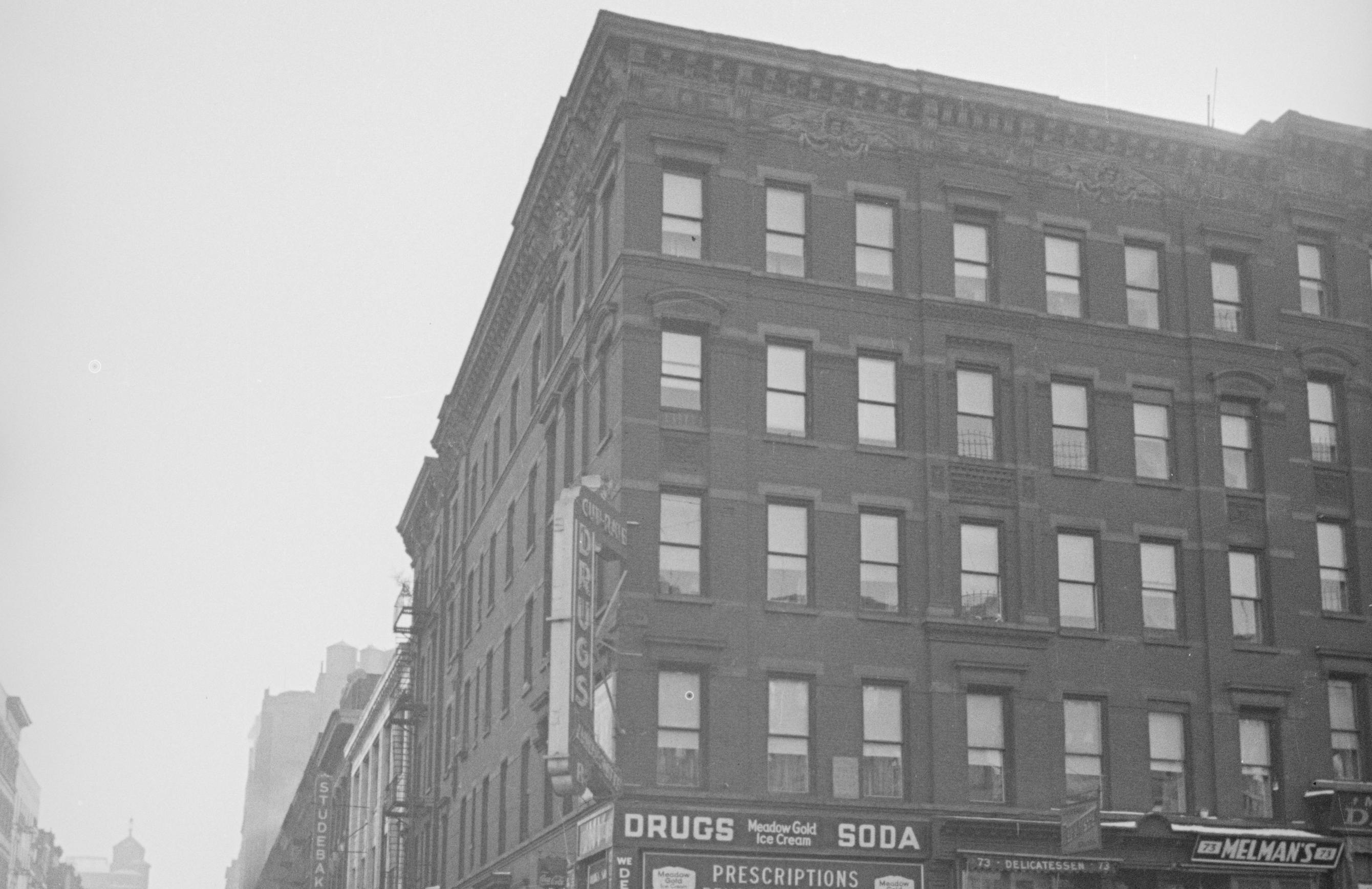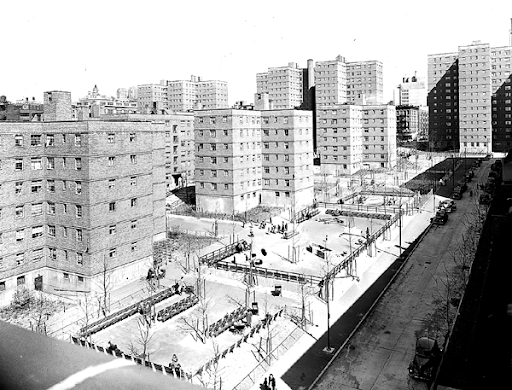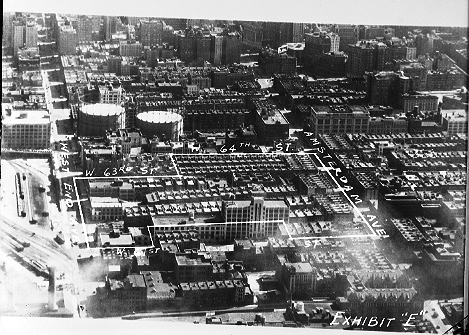
75 Amsterdam Avenue
by Jessica Larson
This five-story corner building was built in 1886 and designed by architect Julius Kastner, along with its neighboring buildings at 69-73 Amsterdam Ave. Kastner had made a career designing both high-end mansions and more modest tenements, as well as commercial spaces throughout the city. The building’s owner was Conrad Stein, an immigrant who had moved to the U.S. in 1835 and owned the Conrad Stein Brewery at 514-516 West 57th Street. Stein owned numerous mixed-use properties on the Upper West Side.
Like many structures throughout the city, the first floor of 75 Amsterdam was used as a commercial space while the upper four stories were apartments. In 1900, the first year for which a federal census is available for the site, six households were listed as residing at the address. These included tenants from Ireland, Germany, and the United States. In some units, multiple generations lived together; for example, Francis and Mary Carey, immigrants from Ireland, lived with their two single adult children, two minor children, their married daughter and her husband, and their baby. The Mayer family, who had German roots, consisted of a husband, wife, and their five children. Their occupations ranged from railroad engineer, milliner, to grocer. For a time in the late 1890s and early 1900s, a saloon was located on the ground floor. The proprietor, Edward Reilly, got into legal trouble for operating the barroom on Sundays.
By 1910, four households lived in the building. The German family still lived there, as well as two more German families and a Hungarian family. One of the new German additions, the Kayser family, owned the ground floor’s pharmacy. Jacob Kayser’s pharmacy had previously been at 81 Amsterdam Avenue but relocated to 75 Amsterdam in 1904. German immigrants were particularly influential in shaping the pharmaceutical industry in New York City. Beginning in the 1830s, these immigrants brought with them the more specialized training that they had received at newly created medical schools in Germany and, once in New York City, opened apothecaries across the city.
The brothers insisted that the alcohol was medicinal, however.
In 1912, Stein sold the property, along with the adjacent building at 152 West 63rd Street, to Fisher Lewine, Irving I. Lewine, and Isidor H. Kempner (aka Kenton Realty Co.). The firm began to buy up huge swathes of real estate on the Upper West Side in the first few decades of the twentieth century, sensing the money to be made in speculative real estate as the area developed.
In 1915, the Viscardi Brothers –Anthony and Frank Viscardi – purchased the ground floor pharmacy business from Kayser, as well as the building at 73 Amsterdam Ave. Anthony Viscardi lived at 75 Amsterdam along with his wife and two young children. The Viscardi Brothers’ pharmacy was mired in legal troubles. In September 1921, one year after Prohibition was passed in the United States, the two brothers were arrested by federal agents for selling alcohol. The brothers insisted that the alcohol was medicinal, however. A notable detail included in press coverage was that the federal agents who arrested the brothers were all Black –certainly unusual for the time. While San Juan Hill surrounding 75 Amsterdam Avenue had many Black residents, Amsterdam Avenue was often considered the “dividing line” between the white sections of the Upper West Side to the east and the Black population to the west. In 1924, the pharmacy was in trouble again when a nurse working for the store was caught forging morphine prescriptions.
For the next couple of decades, 75 Amsterdam Avenue continued to be occupied by European immigrants from Ireland, Germany, and Italy. By 1950, a French family lived alongside American and Italian tenants. The building soon fell victim to the Lincoln Square Renewal Project and was part of the area designated for Lincoln Center for the Performing Arts, for which construction began in 1959.
Resources:
1900 United States Federal Census, New York, Borough of Manhattan, Enumeration District 452, Election District 7-8, Ward 19, image 45 of 51. Familysearch.com
1910 United States Federal Census, New York, Borough of Manhattan, Enumeration District 1312, Ward 22, image 42 of 52. Familysearch.com
1950 United States Federal Census, New York, Borough of Manhattan, Enumeration District 460, Assembly District 5, image 29 of 54. Familysearch.com
“Manhattan Sales.” The Sun. Nov. 21, 1912: p. 15.
“Manhattan Pharmaceutical Associations.” The Druggists Circular and Chemical Gazette 46, no. 12 (Dec., 1902): p. clii.
“New York Notes.” The Pharmaceutical Era 31, no. 19 (May 12, 1904): p. 463.
“Nurse is Accused of Forging Prescription.” Brooklyn Eagle. Jul. 1, 1924: p. 17.
“Quite Personal.” The Practical Druggist 33 (January, 1915): p. 59.
“Real Estate Section.” Real Estate Record and Builders’ Guide 118, no. 8 (Feb. 19, 1927): p. 10.
“State Capitol News.” The Brooklyn Daily Times. Nov 19, 1903: p. 9.
Trow (formerly Wilson’s) Copartnership and Corporation Directory of the Boroughs of Manhattan and the Bronx, City of New York. New York: Trow Directory, Printing & Book Binding Co.,1914.
“Two More Druggists Held in Dry Dive on Tonics.” New-York Tribune. Sep. 25, 1921: p. 10.
Zebroski, Bob. A Brief History of Pharmacy: Humanity’s Search for Wellness. New York: Taylor & Francis, 2015
Jessica Larson is a PhD Candidate in the Department of Art History, The Graduate Center, CUNY. She is also the Joe and Wanda Corn Predoctoral Fellow at the Smithsonian American Art Museum & National Museum of American History




